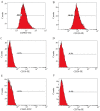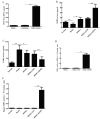Transplantation of human matrix metalloproteinase-1 gene-modified bone marrow-derived mesenchymal stem cell attenuates CCL4-induced liver fibrosis in rats
- PMID: 29512750
- PMCID: PMC5881841
- DOI: 10.3892/ijmm.2018.3516
Transplantation of human matrix metalloproteinase-1 gene-modified bone marrow-derived mesenchymal stem cell attenuates CCL4-induced liver fibrosis in rats
Abstract
It has been reported that bone marrow-derived mesenchymal stem cells (BMSCs) alleviated liver fibrosis. We investigated whether BMSCs transfected with human matrix metalloproteinase 1 (BMSCs/MMP1) would improve their therapeutic effect in liver fibrosis induced by carbon tetrachloride (CCl4) in rats. BMSCs were transfected with an adenovirus carrying enhanced green fluorescence protein (GFP) and human MMP1 gene. BMSCs or BMSCs/MMP1 were directly injected into fibrotic rats via the tail vein. GFP-labeled cells appeared in the fibrotic liver after BMSC transplantation. The expression of BMSCs/MMP1 elevated levels of MMP1 in vitro. Although BMSC administration reduced liver fibrosis, transplantation of BMSCs/MMP1 enhanced the reduction of liver fibrosis to a higher level. Treatment with BMSCs/MMP1 not only decreased collagen content but also suppressed activation of hepatic stellate cells (HSCs) in fibrotic liver, which led to subsequent improvement of both liver injury and fibrosis. Treatment with BMSCs/MMP1 resulted in an improved therapeutic effect compared with BMSCs alone, which is probably because of the sustainably expressed MMP1 level in the liver. BMSCs/MMP1 transplantation not only improved biochemical parameters but also attenuated progression of liver fibrosis, suggesting that BMSCs may be a potential cell source in preventing liver fibrosis and MMP1 gene may enhance the anti-fibrotic effect of BMSCs.
Figures






Similar articles
-
[Therapeutic effect of BMSCs with over-expressed MMP1 on liver fibrosis].Zhong Nan Da Xue Xue Bao Yi Xue Ban. 2014 Mar;39(3):258-64. doi: 10.11817/j.issn.1672-7347.2014.03.006. Zhong Nan Da Xue Xue Bao Yi Xue Ban. 2014. PMID: 24748190 Chinese.
-
Bone Marrow Mesenchymal Stem Cells Reverse Liver Damage in a Carbon Tetrachloride-induced Mouse Model of Chronic Liver Injury.In Vivo. 2016 May-Jun;30(3):187-93. In Vivo. 2016. PMID: 27107074
-
[Recombinant adenovirus Ad-human matrix metalloproteinase 1 transfecting bone marrow mesenchymal stem cells of rats in vitro].Zhongguo Xiu Fu Chong Jian Wai Ke Za Zhi. 2013 May;27(5):529-34. Zhongguo Xiu Fu Chong Jian Wai Ke Za Zhi. 2013. PMID: 23879087 Chinese.
-
[Application of mesenchymal stem cells to liver regenerative medicine].Yakugaku Zasshi. 2008 Jan;128(1):3-9. doi: 10.1248/yakushi.128.3. Yakugaku Zasshi. 2008. PMID: 18176050 Review. Japanese.
-
Therapeutic potential of adult bone marrow stem cells in liver disease and delivery approaches.Stem Cell Rev. 2008 Summer;4(2):101-12. doi: 10.1007/s12015-008-9019-z. Stem Cell Rev. 2008. PMID: 18481229 Review.
Cited by
-
Advance of Mesenchymal Stem Cells in Chronic End-Stage Liver Disease Control.Stem Cells Int. 2022 Oct 7;2022:1526217. doi: 10.1155/2022/1526217. eCollection 2022. Stem Cells Int. 2022. PMID: 36248254 Free PMC article. Review.
-
Progress of Interference of Traditional Chinese Medicine on Cirrhosis Treated with Bone Marrow Mesenchymal Stem Cells.Evid Based Complement Alternat Med. 2021 May 11;2021:5569274. doi: 10.1155/2021/5569274. eCollection 2021. Evid Based Complement Alternat Med. 2021. PMID: 34055009 Free PMC article. Review.
-
Multiple Dimensions of using Mesenchymal Stem Cells for Treating Liver Diseases: From Bench to Beside.Stem Cell Rev Rep. 2023 Oct;19(7):2192-2224. doi: 10.1007/s12015-023-10583-5. Epub 2023 Jul 27. Stem Cell Rev Rep. 2023. PMID: 37498509 Review.
-
Therapeutic utility of mesenchymal stromal cell (MSC)-based approaches in chronic neurodegeneration: a glimpse into underlying mechanisms, current status, and prospects.Cell Mol Biol Lett. 2022 Jul 16;27(1):56. doi: 10.1186/s11658-022-00359-z. Cell Mol Biol Lett. 2022. PMID: 35842587 Free PMC article. Review.
-
Reversal of established liver fibrosis by IC-2-engineered mesenchymal stem cell sheets.Sci Rep. 2019 May 2;9(1):6841. doi: 10.1038/s41598-019-43298-0. Sci Rep. 2019. PMID: 31048740 Free PMC article.
References
MeSH terms
Substances
LinkOut - more resources
Full Text Sources
Other Literature Sources
Medical

